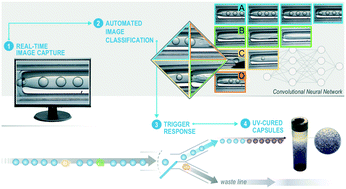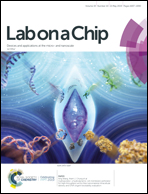Automated detection and sorting of microencapsulation via machine learning†
Abstract
Microfluidic-based microencapsulation requires significant oversight to prevent material and quality loss due to sporadic disruptions in fluid flow that routinely arise. State-of-the-art microcapsule production is laborious and relies on experts to monitor the process, e.g. through a microscope. Unnoticed defects diminish the quality of collected material and/or may cause irreversible clogging. To address these issues, we developed an automated monitoring and sorting system that operates on consumer-grade hardware in real-time. Using human-labeled microscope images acquired during typical operation, we train a convolutional neural network that assesses microencapsulation. Based on output from the machine learning algorithm, an integrated valving system collects desirable microcapsules or diverts waste material accordingly. Although the system notifies operators to make necessary adjustments to restore microencapsulation, we can extend the system to automate corrections. Since microfluidic-based production platforms customarily collect image and sensor data, machine learning can help to scale up and improve microfluidic techniques beyond microencapsulation.



 Please wait while we load your content...
Please wait while we load your content...